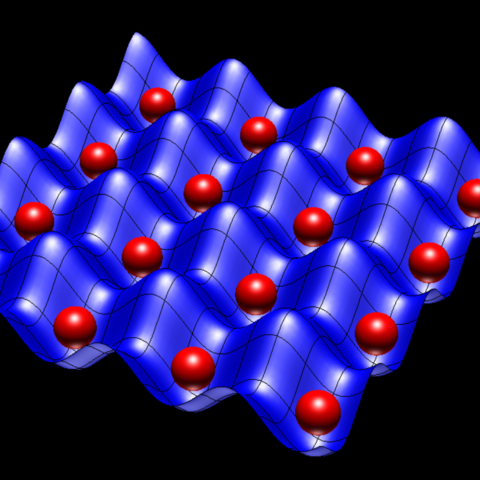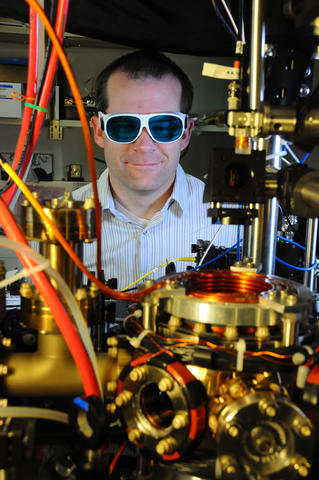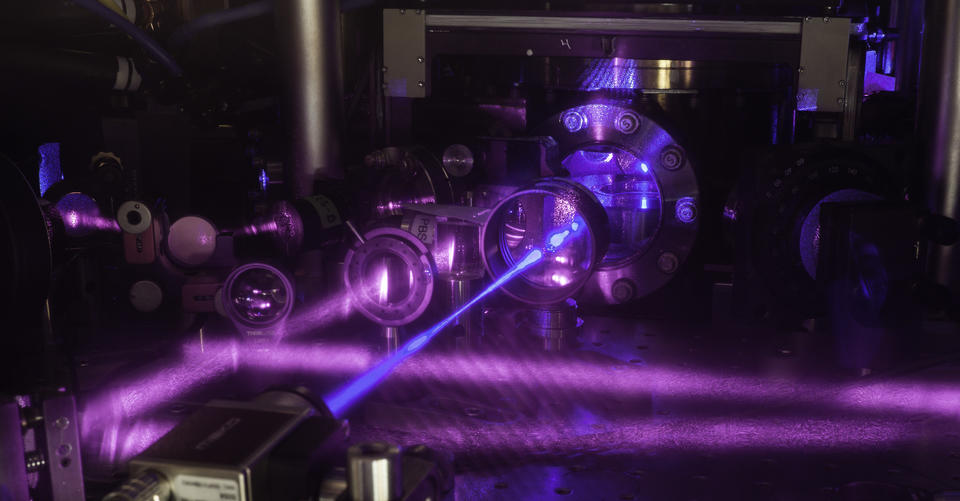Optical Lattices: Webs of Light
Researchers from the National Institute of Standards and Technology (NIST) are among the world leaders in studying and using optical lattices, webs of light that trap atoms in an orderly arrangement like eggs in a carton.

The best-known applications of optical lattices are next-generation atomic clocks based on ytterbium or strontium atoms. Clocks based on these atoms operate at optical frequencies, much higher than the microwave frequencies of today’s standard atomic clocks based on cesium atoms, and therefore promise higher degrees of precision in timekeeping.
Optical lattices can also serve as flexible laboratories for cutting-edge basic research. For example, atoms and molecules in optical lattices can be used in quantum simulations, to help researchers model complex quantum processes such as magnetism or to potentially create novel materials and systems.
In addition, optical lattices offer one possible platform for quantum computers, which may one day solve problems that are intractable with today’s computing technology.
How Are Optical Lattices Created?
Among their many uses, laser beams can trap matter such as atoms and molecules. Two or more intersecting laser beams can combine and “interfere” to form a standing wave, an array of peaks and valleys of light intensity. Depending on the number and arrangement of the laser beams, the standing wave can extend in multiple directions to resemble an egg carton, or even a 3D grid. Ultracold atoms or molecules can then become trapped in the peaks and valleys of the standing wave. The overall arrangement is called an optical lattice because the light forms a repeating pattern, much like the naturally occurring lattice structure of solid crystals.
Optical lattices can trap atoms in one-, two- or three-dimensional arrays. The lattice spacing — the distance between neighboring trapping sites — is typically half of the laser light’s wavelength. Scientists can change this angle, or the wavelength, to change the spacing.
In addition to affecting the spacing between valleys, the laser wavelength can also influence the way in which the atoms are trapped. This is because the atoms respond differently to different colors (wavelengths) of light. Some colors can even drive an atom’s electrons to change energy levels, and near these colors the light’s trapping force can be especially strong. If the wavelength is longer than such a “resonance” wavelength, atoms are attracted to the strongest light intensity — the peaks — while if the wavelength is shorter than resonance, the atoms are attracted to the lowest light intensity — the valleys. Tuning the laser intensity adjusts how strongly the atoms are trapped. Often, magnetic or electric fields are used in tandem with the optical lattice, offering additional control over the atoms’ and molecules’ behavior.

Because the atoms are governed by the rules of quantum mechanics, they can sometimes “tunnel” or “hop” between lattice sites, even though they lack the energy usually needed to go over the barriers that separate the trapping sites. Higher light intensity, and hence higher barriers, reduce the rate of this tunneling process.
Origins of the Idea and Early Experiments
Soviet physicist Vladilen Letokhov introduced the idea of optical lattices more than a half century ago, in the 1960s.
Researchers began to create such light traps in the laboratory in the late 1980s, when a team led by NIST Nobel laureate William Phillips discovered by accident that its laser-cooled atoms were being held in an optical lattice. In trying to measure the temperature of atoms cooled by intersecting laser beams, his team was surprised to find the atoms confined in an array of microscopic traps resulting from the standing wave formed by the beams.
Optical Lattice Clocks
Clocks using atoms trapped in an optical lattice, rather than the historical approach of using a “cloud” of unconfined neutral atoms, dramatically reduce the influence of atomic motion on the clock’s ticking.
Hidetoshi Katori of the University of Tokyo is credited with proposing (in 2001) and making (in 2003) the very first lattice clock, based on strontium atoms. He used lasers at a "magic wavelength," at which optically trapping atoms would not perturb the “clock frequency,” the frequency of the transition between energy levels that determines the ticking rate of the clock. Independently, the idea of the magic wavelength for optical trapping was developed in the group of Jeff Kimble of Caltech in the late 1990s. Among the postdocs in this group was Jun Ye, who then joined JILA, jointly operated by NIST and the University of Colorado Boulder.
As the nation’s civilian timekeeping agency, NIST is always working to improve atomic clocks and develop potential future time standards, including lattice clocks. In 2000, Jun Ye, Andrew Ludlow and colleagues started working with strontium in efforts that would lead to the first JILA optical lattice clock, reported in January 2006.
A small team of NIST scientists led by Chris Oates and Leo Hollberg developed the first lattice clock based on the ytterbium atom. Today’s optical clocks are so good that scientists generally expect a new international definition of the second, using an optical transition frequency, in the not-so-distant future.

Further Development of Optical Lattice Theory
Ana Maria Rey, a NIST physicist at JILA, has contributed important theoretical work, including models that have helped to improve clock performance by identifying and explaining quantum interactions between multiple particles in optical lattices. For example, JILA researchers also used their 3D lattice clock to isolate groups of a few atoms and precisely measure their multiparticle interactions.

They found that with three or more atoms per lattice site, the clock’s ticking frequency shifts more than expected. This is because each atom contributes to the overall quantum state, and the atoms can all interact simultaneously instead of in a pair-wise fashion. A single atom is likely to remain in a lattice site for a much longer time and is thus ideal for an atomic clock.
The advance will help scientists control interacting quantum matter, which is expected to boost the performance of atomic clocks, many types of sensors, and quantum information systems.
Quantum Information and Quantum Physics Simulations
Parallel with the development of lattice clocks, NIST researchers since the 2000s have explored the use of atoms in optical lattices to perform quantum computations and simulate mysterious phenomena in quantum physics. Pioneers in this area include researchers at the Joint Quantum Institute, a research partnership between NIST and the University of Maryland. Trey Porto and colleagues, for example, are exploring the use of lattice atoms as quantum simulators of complex materials. For more than a decade, the groups led by Jun Ye and the late Debbie Jin at JILA have also used molecules confined in lattices to investigate quantum physics, fundamental chemistry and quantum information.
Optical lattices, once a theoretical concept, now promise to blossom into many of the world’s best clocks, simulators of quantum physics, and so much more.

